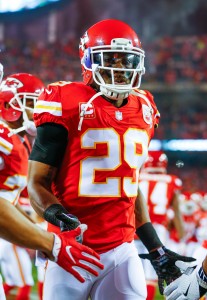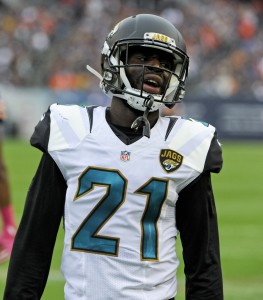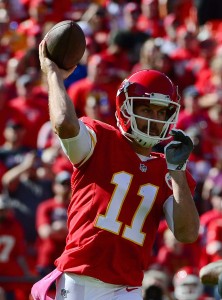In advance of March 9, the start of free agency in the NFL, Pro Football Rumors will detail each team’s three most glaring roster issues. We’ll continue this year’s series with the Kansas City Chiefs, who continued their steady run under Andy Reid and John Dorsey by winning the AFC West for the first time in six years and qualifying for the divisional round of the playoffs for the second straight season.
Depth Chart (via Roster Resource)
Pending Free Agents:
- Eric Berry, S
- Kenny Cook, WR (ERFA)
- Knile Davis, RB
- Jarvis Jenkins, DE
- Josh Mauga, LB
- Trey Millard, RB (RFA)
- Dontari Poe, DT
- Kendall Reyes, DE
- Cairo Santos, K (RFA)
- Daniel Sorensen, S (RFA)
- Albert Wilson, WR (RFA)
Top Cap Hits for 2017:
- Justin Houston, LB: $22,100,000
- Alex Smith, QB: $16,900,000
- Jeremy Maclin, WR: $12,400,000
- Nick Foles, QB: $10,750,000
- Eric Fisher, T: $9,457,777
- Tamba Hali, LB: $8,583,333
- Derrick Johnson, LB: $7,562,500
- Mitchell Schwartz, T: $6,900,000
- Jaye Howard, DL: $6,375,000
- Jamaal Charles, RB: $6,187,500
Other:
- Projected cap space (via OverTheCap): $4,678,573
- Twenty-seventh pick in draft
- Must exercise or decline 2018 fifth-year option on Dee Ford
Three Needs:
1.) Finalize secondary plans: Eric Berry‘s situation will once again be at the forefront of Kansas City’s offseason, but the Chiefs also could use some assistance at their right cornerback spot opposite Marcus Peters. The AFC West champions bent constantly but didn’t break often, as best evidenced by the unique divisional-round loss to the Steelers, but they have a decision to make regarding their defensive leader.
 Among active safeties, only Earl Thomas matches Berry’s three first-team All-Pro honors, and Eric Weddle is the only one to have two such distinctions on his resume. So, Berry has a legitimate case to be the league’s highest-paid safety. He has not been underpaid by any stretch of the imagination, being one of the league’s three players to make it from the 2010 first round — the last featuring the old CBA setup friendlier towards first-rounders — to the end of the 2015 season on his rookie deal. And after the Chiefs couldn’t come to an agreement with Berry last July, he earned $10.806MM on the franchise tag. Long-term security eludes Berry, but he remains in position to cash in.
Among active safeties, only Earl Thomas matches Berry’s three first-team All-Pro honors, and Eric Weddle is the only one to have two such distinctions on his resume. So, Berry has a legitimate case to be the league’s highest-paid safety. He has not been underpaid by any stretch of the imagination, being one of the league’s three players to make it from the 2010 first round — the last featuring the old CBA setup friendlier towards first-rounders — to the end of the 2015 season on his rookie deal. And after the Chiefs couldn’t come to an agreement with Berry last July, he earned $10.806MM on the franchise tag. Long-term security eludes Berry, but he remains in position to cash in.
The Chiefs can shed more than $17MM in cap space by releasing Jamaal Charles and Nick Foles, creating some room for a Berry re-up. Retaining both Berry and Dontari Poe could be a stretch, but the Chiefs under John Dorsey and Andy Reid are known for backloading deals. That’s allowed them to sign Jeremy Maclin and Mitchell Schwartz despite not being cap-rich the past two offseasons. As for Berry, he will be set for his age-28 season in 2017, so a long-term deal should be reasonable.
The former No. 5 overall pick won comeback player of the year honors in 2015 but was even better in 2016, intercepting four passes and scoring two seminal defensive touchdowns — without which the Chiefs may have lost two more games this season — and is a darkhorse Defensive Player of the Year candidate. He also returned to a full-season workload after being gradually worked back into his old role in 2015 following his triumphant cancer comeback. Thanks to his on-field success and his successful battle with cancer, Berry has become the team’s most popular player. The sides weren’t close on a deal last summer but may be more in sync this year after Berry’s full-season performance. Reid lists Berry high on the Chiefs’ priority list, but the safety landscape has changed since the sides last negotiated.
Tyrann Mathieu became the highest-paid safety on a five-year, $62.5MM deal late last summer. Berry’s camp could state his case by citing his All-Pro honors and relative durability, along with the fact that the cap is expected to approach $170MM this year. The Chiefs would likely argue the Cardinals use Mathieu more as a cornerback than a safety, plus they will point out that Mathieu is four years younger than Berry. Regardless, Berry won’t be settling for a deal worth less than Harrison Smith‘s five-year, $51.25MM pact.
Kansas City has locked up many core defenders in the recent past — re-signing Justin Houston, Derrick Johnson and Tamba Hali — and ancillary parts like Ron Parker, Allen Bailey and Jaye Howard, illustrating Dorsey’s build-from-within model. A Berry deal — or a season in which the cornerstone safety plays on another franchise tag, which would be projected at $12.967MM — would limit the Chiefs’ ability to fortify the rest of their secondary. But it would be interesting to see Dorsey re-sign so many roster linchpins — re-upping Johnson and Hali from the Carl Peterson era, retaining Houston from the Scott Pioli period, and then locking up current-regime-acquired Travis Kelce — but fail to come to terms with the most popular player the Chiefs have employed this decade.
 Kansas City has only rookie-deal players signed at corner, and recent third-round investments — Phillip Gaines (2014), Steven Nelson (2015), and KeiVarae Russell (2016) — have not produced a surefire starter. Nelson’s been the best of the bunch, operating as their slot corner, with Gaines playing his way out of the lineup during his third season. Russell, meanwhile, became a rare Day 2 pick to be cut as a rookie. Practice squad promotion Terrance Mitchell served as K.C.’s right cornerback down the stretch, despite the fact that the team drafting three corners last year. The Chiefs could target some second-tier UFA cogs or continue to try their hand with rookies.
Kansas City has only rookie-deal players signed at corner, and recent third-round investments — Phillip Gaines (2014), Steven Nelson (2015), and KeiVarae Russell (2016) — have not produced a surefire starter. Nelson’s been the best of the bunch, operating as their slot corner, with Gaines playing his way out of the lineup during his third season. Russell, meanwhile, became a rare Day 2 pick to be cut as a rookie. Practice squad promotion Terrance Mitchell served as K.C.’s right cornerback down the stretch, despite the fact that the team drafting three corners last year. The Chiefs could target some second-tier UFA cogs or continue to try their hand with rookies.
They had this same need last year but didn’t pursue Prince Amukamara aggressively. Now that he stands to be back on the market, the 27-year-old looks like a second-tier candidate in a fairly well-stocked cornerback market. He’ll be seeking a multiyear deal after showcasing some durability that his Giants years lacked, but the former first-rounder doesn’t figure to be out of Kansas City’s price range. The cornerback market also features Trumaine Johnson, A.J. Bouye, Dre Kirkpatrick, Stephon Gilmore, Logan Ryan, and Darius Butler. Not all of those players are going to sign $10MM-per-year pacts. If a veteran like Poe comes off the Chiefs’ books, finding an additional boundary corner would be a place to reinvest that money on a team without many glaring needs.
If the Chiefs want to take the route the Bengals have in recent years, fortifying the position through the first round, that would obviously be a cheaper option. LSU’s Tre’Davious White, Florida’s Quincy Wilson, Clemson’s Cordrea Tankersley, or Peters’ college teammate Sidney Jones could be options by the time the Chiefs’ pick with No. 27 overall selection. NFL.com’s Chad Reuter believes standout Gators stopper Teez Tabor could fall to the Chiefs at 27, and Pro Football Focus’ Steve Palazzolo sees 5-foot-10 Michigan corner Jourdan Lewis going to the Chiefs in his mock draft. This position looks to be deep for the teams with late-first-round choices, and that could be the route the Chiefs take, both for financial considerations and because some key members of their core either older than 30 or approaching it. The Chiefs need a promising contributor at this spot to keep teams from avoiding Peters.
2.) Figure out a post-Derrick Johnson future: The inside linebacker has enjoyed a long and productive career for the Chiefs, having signed a contract with three Kansas City regimes and serving as an 11-year starter. But Johnson will turn 35 next season and sustained a severe Achilles injury for the second time in three years. Kansas City’s run defense did not perform well in 2016, ranking 26th against the rush, and that became an even more glaring problem after Johnson’s mid-December injury. Le’Veon Bell consistently marched the Steelers into field goal range in the teams’ divisional-round meeting, and the running back’s methodical sojourns into the red zone led to to the Chiefs’ elimination.
Johnson has stood as the rock of the Chiefs’ run defense for years, most recently evidenced by its rapid improvement in 2015 upon his return. But it’s time to fortify this position, because the Chiefs don’t have much else there.
 In addition to the four-time Pro Bowler, the Chiefs boast bottom-end investments at inside linebacker. Ramik Wilson, a 2015 fourth-rounder, and Justin March-Lillard, a 2015 UDFA, represent the team’s top prospects. Josh Mauga suffered a season-ending injury over the summer, and when Johnson couldn’t play in the final four games, the Chiefs were down to their spare parts in crucial spots. A two-year starter, Mauga is a UFA. Johnson will almost certainly be on the roster in 2017 since he signed a three-year, $21MM deal to stay in western Missouri last March. The dead money/cap savings ratio does not add up for an early cut, and Johnson could still make an impact as he did coming off the 2014 Achilles injury. He’s not considering retirement.
In addition to the four-time Pro Bowler, the Chiefs boast bottom-end investments at inside linebacker. Ramik Wilson, a 2015 fourth-rounder, and Justin March-Lillard, a 2015 UDFA, represent the team’s top prospects. Josh Mauga suffered a season-ending injury over the summer, and when Johnson couldn’t play in the final four games, the Chiefs were down to their spare parts in crucial spots. A two-year starter, Mauga is a UFA. Johnson will almost certainly be on the roster in 2017 since he signed a three-year, $21MM deal to stay in western Missouri last March. The dead money/cap savings ratio does not add up for an early cut, and Johnson could still make an impact as he did coming off the 2014 Achilles injury. He’s not considering retirement.
But this remains an area in desperate need of a young talent, because Johnson’s latest injury may render him unable to return to his previous level. The options aren’t plentiful in free agency, but the Chiefs should probably be looking to the draft for help here. They need a long-term successor. If the Chiefs believe this is a bigger issue than CB2, there are are a few ILBs who could be had at the back end of the first round.
Vanderbilt’s Zach Cunningham dominated as a sideline-to-sideline player, finishing with 125 tackles (16.5 for loss) in 13 games last season. Ohio State’s Raekwon McMillan (102 stops last year) and Northwestern’s Anthony Walker (29 TFLs since 2015) fit the profile as well. Of course, quality 3-4 inside linebackers can be acquired later in the draft, as the likes of AFC West rivals Brandon Marshall and Denzel Perryman prove. With inside ‘backers not the most coveted of commodities come April, the Chiefs could see one of those aforementioned three prospects potentially fall to them in the second round, where they hold the No. 59 overall choice.
3.) Assess Alex Smith‘s viability: In a town known for employing polarizing quarterbacks, Smith has served as a lightning rod during most of his tenure. The latest narrow Chiefs postseason defeat continued to cast doubt on Smith’s ability to lead this team deep into the playoffs. However, Kansas City remains committed to him on what’s become one of the lower-end deals for a franchise quarterback. The former No. 1 overall pick has two years left on his contract and will only turn 33 in May, but the Chiefs are 1-3 in the playoffs behind Smith. Smith’s outing against the Steelers may have been the worst of his playoff performances in Kansas City, which has a veteran nucleus whose window depends on the middling passer.
 While a report identified the Broncos as Tony Romo‘s top target, they would only be interested in him if he were to be released. The Texans, too, have emerged as a speculative landing spot, but the Broncos just invested a first-round pick in Paxton Lynch, and the Texans would incur a $25MM dead money blow by moving on from Brock Osweiler. The Chiefs have a steadier option than both teams from a short-term perspective, with Smith having quarterbacked the team during its mid-2010s resurgence. But they may be a stealth Romo candidate due to their status in the NFL pecking order.
While a report identified the Broncos as Tony Romo‘s top target, they would only be interested in him if he were to be released. The Texans, too, have emerged as a speculative landing spot, but the Broncos just invested a first-round pick in Paxton Lynch, and the Texans would incur a $25MM dead money blow by moving on from Brock Osweiler. The Chiefs have a steadier option than both teams from a short-term perspective, with Smith having quarterbacked the team during its mid-2010s resurgence. But they may be a stealth Romo candidate due to their status in the NFL pecking order.
The Chiefs’ 43 wins since 2013 trail only the Patriots, Seahawks and Broncos. But as Adam Teicher of ESPN.com notes, the team may have gone as far as it could with Smith under center. This echoes a sentiment Chiefs sources expressed during the Chiefs’ march to the AFC West crown. In 15 starts in 2016, the risk-averse passer threw just 15 touchdown passes. It would cost the franchise less to separate from Smith this year, at $7.2MM in dead money. The Chiefs would not be able to afford a Romo trade on his current deal (league-high $24.7MM cap number in 2017), but on a renegotiated contract, this landing spot makes sense for the 37-year-old passer.
If healthy, Romo is an upgrade over Smith. The other passers who figure to be available via trade or as UFAs probably are not. However, the Chiefs have an incredibly long track record of failing to develop a passer. From the four 49ers-honed quarterbacks over the past 20-plus years, to Trent Green and Matt Cassel, the Hunt family and their GMs have a long track-record of pursuing veterans. Of course, if management determines the best way to keep this core’s championship window open is to further strengthen the roster around Smith, then a prospect passer could be considered.
The Chiefs have drafted Day 3 quarterbacks in two of the past three years, Aaron Murray and Kevin Hogan, but neither is currently on the team. UDFA Tyler Bray is currently the Chiefs’ third-stringer. They haven’t selected a quarterback in the first round since the Todd Blackledge misfire in 1983 and haven’t spent a second-round selection on this position in 25 years. This quarterback class might see three polarizing passers — Deshaun Watson, Mitch Trubisky, and DeShone Kizer — go off the board before the Chiefs pick in Round 1. But they could consider Texas Tech’s Patrick Mahomes, either via first-round pick or second-round trade-up, or Miami’s Brad Kaaya in Round 2. Neither would likely be ready for a bit, keeping the Chiefs a Smith-run operation for at least 2017 and possibly 2018.
The franchise sits at a crossroads after its fourth consecutive home playoff loss. How it operates in the coming months here, either supplying Smith with more help or bringing in his replacement/successor, will be critical to changing this enduring trajectory.
Romo is not an upgrade over Smith. He’s older, fragile, and has led his current team to nothing more than Smith has done.
It’s time Chiefs move on from Smith. I would make a block buster draft day trade to move up and get Watson. To move this franchise forward and energize this city!
Romo can throw the ball downfield. Smith can’t. So yeah, Romo IS an upgrade.
I disagree link to milehighreport.com
Can keep Smith and a Draft QB for the future. Their will be one available at their pick.